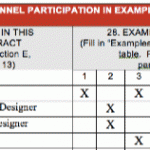 Now that the holidays are officially over, let’s have a little talk.
Now that the holidays are officially over, let’s have a little talk.
Over the past ten years, firms have abandoned giving out gifts or cards to their clients during the holidays. Instead, a large majority of firms send a blast holiday email.
It’s a very common thing in our industry that nearly everyone accepts as OK, and most people think is pretty neat. I’m going to explain why I firmly believe sending a generic holiday email blast is a horrible mistake.
The holiday emails I’m speaking of take a few different forms.
- A non-religious holiday image with a generic hallmarky message.
- A photo of your staff with a hallmarky message.
- Photo or video of your staff’s children trying to be cute.
- A big logo. When I click on it, it goes to some pointless flash animation or video.
- Some combination of 1-5, with a list of charities you support (or are donating to on my supposed behalf).
Your Excuse
The common “reason” given is that sending emails is more sustainable. I’m not going to argue that.
But here’s the other side of the coin. Firms have asked marketing departments to do more with less. A card costs $2 and an email costs less than two cents. Therefore, it’s cheaper and you’ll “reach” many more people with an email.
It also takes significantly less time and effort to send 1,000 emails than 1,000 cards or gifts. Not all Principals want to spend all day writing personalized, thoughtful messages on hundreds of cards. And trust me, spending days stuffing and labeling 1,000 custom chocolate bars isn’t anybody’s idea of a fun time (especially if you have a reduced marketing staff).
So, I’ll admit it is reasonable to believe that Mother Earth prefers emails. But you need to admit, it is also a hell of a lot easier and cheaper for your firm.
Let’s Think About This
Here’s the harsh reality. Sending a blast holiday email shows that you could really care less about your clients/friends/teaming partners and are only willing to do the bare minimum (an email blast).
On top of that, you are just copycatting what every other firm in the A/E/C industry now does, one generic holiday message to rule them all. No value included, just an exercise in wasting people’s time (so they won’t “forget you”).
These emails fail even in their self-serving intention, because they are just like the countless holiday emails every would-be client or teaming partner will get during the holiday (instantly forgotten after you click delete).
Nine times out of ten, the recipient will not even know who decided they should get the email, even when they know your firm. If they don’t know (or remember) your firm, it will be seen as an advertisement…a blatant and self-serving disrespect of the recipient’s time.
Look At Your Open Rates
Think I’m over exaggerating? Look at your open rates for these holiday emails. How many people opened your holiday email this year? 20%? 40%?
If your holiday email blast had an open rate of more than 60%, post a link to it in the comments because I’ll be shocked. The industry average is 15%.
At best, 40% of the people you send these to don’t even open them…don’t even open them. More likely, 85% of the people you send these to don’t open them.
Now let me ask you this. Have you ever received a holiday card in the regular mail and not open it? I haven’t. I mean, what kind of Scrooge do you need to be to not open a card you receive in the mail?
Now, have you ever received a holiday email and didn’t get around to opening it? I have. And I’m willing to bet you have, too.
Are you beginning to see the problem here?
The Mother Test
You wouldn’t send your mother a generic holiday email, why would you send one to a client?
Why would you send the individuals who have enabled you and your coworkers to live a life that’s better than 99% of the people on this planet a generic holiday email blast?
Think about that!
Standing Out With Your Clients
I’ve never personally hired an architect or engineer. Yet, I receive at least 50 of these emails (starting on Thanksgiving and ending mid-January). Most of the time they are from firms I have either never heard of or have forgotten about.
Different is Better (Broken Record)
You are a fool if you think every other firm doing it is a reason for you to do it. Everybody else doing it is, in fact, the reason you should do something different.
Let me shake you one more time screaming, “Different is better than better!!!”
The Best Corporate Holiday Card I Ever Received
The best I ever received was from a friend at TY Lin. It was a card with a personalized message. The card also included a “gift card” worth $1 that I could designate to a charity of my choosing.
By redeeming that card, I felt like I was being a good person. Granted, I’m sure it cost way more than $1 to send it. But when you are dealing with people who can’t accept gifts, $1 (for you to give away) would be hard to classify as a gift.
Paper Cards Are Not The Solution
Want to hear what’s even worse than a blast email? A blast paper card is. I’m talking about these cards I get that aren’t even signed by an individual. Often they have the name of the firm or a printed list of staff names. Yuck! Thanks for letting me know you could care less.
Let’s contrast that with what I get from Chris Hill. Every year, Chris (a construction lawyer in VA) sends me a holiday card with a funny cartoon on the front. Inside there is a personalized message from Chris to me. Chris is a friend, but he’s also one of my firm’s clients.
He took time out of his day to send me something personalized. What a guy! Seriously, what wouldn’t I do for Chris Hill?
Personalized, Of Value
This is the key. I believe you have to send personalization and/or value.
I sent every HelpEverybodyEveryday.com subscriber “10 Incredible Insights on Creating Winning Proposals.”
As discussed in my last post, I also experimented with sending personalized emails with Zurmo (my CRM).
My firm sent their list a free chapter of our $80 book on construction delays.
And I sent current clients I’ve brought in individual emails where I personally thanked them.
Time For A Change
Generic holiday email blasts shouldn’t be the norm. That shouldn’t be the standard we hold ourselves to when it comes to communicating with our clients and teaming partners. Personalization and value should be the norm.





Good morning Matt and many thanks for articulating what we have been thinking. We have tinkered with our approach to the holidays over the last decade and have come to the following:
To our e-mail marketing mailing list of some 1,700 souls, we do send the pre-packaged Hallmark-ish e-card. Our open rates for it (about 25%) do not differ markedly than what they are for other e-newsletters we generate about every other month.
We do this because years ago when we sent personally-signed holiday cards by snail mail, the process of personally signing them and even adding short notes was super-burdensome time-wise.
We also budget about a piece of our annual marketing budget (say 5% but it would be a lie if we were surgically precise about it like that) for client gifts. We have three tiers of gift size, depending on the economic value of the relationship to our business in the concluding year. The top 3 get large gifts (~$100), the next 7 get medium ones (~$60) and another 15 get small ones ($~30). That’s about $1,200 or so, and what we send are shelf-stable office edibles. The large gifts we endeavor to hand-deliver ourselves, unless distances just make that impractical.
Given #3, I’m still e-marketing. It is cheaper, does triage my list, and it is greener. Doing e-cards for the holidays without gifts is the real mistake IMHO.
Hope this helps in the constructive manner intended. Your blogs always are great.
Mark,
Comments are always welcome.
I think you opt for value opposed to personalization. 1 out of 2 ain’t bad.
Yes, sending personally signed cards (hopefully, they included a personal note) is time consuming. I wonder how much time is each client worth to us? Isn’t it reasonable to give each client 5 free minutes of our time every December?
The client gifts is a good touch. But if you work in the government sector, a $100 gift is a big no no.
I agree on all points with this.
Matt- Agree 100%. Especially the e-mails that require clicking links to get to the holiday e-card… and in one tragically sad case, required the download of a viewer to even SEE the message. Seriously, if you’re going to cheap out on your marketing pieces — fine. But asking me to waste my time clicking links and going to websites and downloading viewers to help you save a buck is insulting.
David,
Thank you for commenting.
This post is so right on! The fastest route to being a commodity is December holiday e-cards. A January New Years message e-card just says you couldn’t meet the deadline.
The sustainability angle is such crap. As mentioned, just be honest by stating that you are sending an e-card because everyone else does. Say that you are susceptible to peer pressure, the guilt of holiday card abstinence is too much, and you don’t want to be thought of as a scrooge.
Why not adopt a non December holiday for your firm and really own it? There are a lot of other great holidays begging for creativity.
David,
Thank you for commenting. The non-december holiday is an interesting idea.
I am a one-person company and things have been very “hand-to-mouth” over the last five years. So I take the time to design my own holiday card, which I then send out myself via email. I don’t use an email service. I started doing it this way in a year when I couldn’t afford to purchase or print 250 paper cards and put postage on each one. When I do it this way, is it considered an “email blast” or just an email?
By the way, you used the phrase “could care less” multiple times. If you think about it, what you want to say is that you don’t care at all. If you don’t care at all, you actually COULDN’T care less. If you “could care less,” then by definition you care some. But don’t make yourself any crazier over it than you need to be; most of the people I know make the same statement.
Yeah, if it is the same email to everyone…that’s an email blast.
“Could care less,” while completely illogical, is right because it is sarcastic.
Enter Harvard University’s Steven Pinker:
A tin ear for stress and melody, and an obliviousness to the principles of discourse and rhetoric, are important tools of the trade for the language maven. Consider an alleged atrocity committed by today’s youth: the expression [I could care less]. The teenagers are trying to express disdain, the adults note, in which case they should be saying [I couldn’t care less]. If they could care less than they do, that means that they really do care, the opposite of what they are trying to say. But if these dudes would stop ragging on teenagers and scope out the construction, they would see that their argument is bogus. Listen to how the two versions are pronounced: COULDN’T care I LE CARE i ESS. LE could ESS. The melodies and stresses are completely different, and for a good reason. The second version is not illogical, it’s [sarcastic]. The point of sarcasm is that by making an assertion that is manifestly false or accompanied by ostentatiously mannered intonation, one deliberately implies its opposite. A good paraphrase is, “Oh yeah, as if there were something in the world that I care less about.”
http://pinker.wjh.harvard.edu/articles/media/1994_01_24_thenewrepublic.html
David your idea about ‘owning’ another holiday is awesome. I’ve been trying to find a happy medium on the holiday card issue. We currently send the eblast cards with a ‘meh’ opening rate. Paper cards have been cost prohibitive over the past few years and historically getting the right people to actually sign the cards and write personal messages almost kills my Christmas spirit. We give gifts and I like to take my clients to a nice holiday lunch. Does anyone have suggestions on a middle ground?